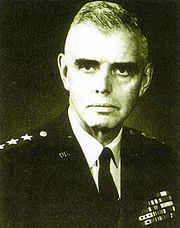| James B. Lampert | |
|---|---|
 James Benjamin Lampert | |
| Born | April 16, 1914 |
| Died | July 10, 1978 (aged 64) |
| Place of birth | Washington, D.C. |
| Place of death | Washington, D.C. |
| Allegiance | United States of America |
| Service/branch | United States Army |
| Years of service | 1936–1972 |
| Rank | Lieutenant General |
| Unit | US Army Corps of Engineers |
| Commands held | Superintendent, United States Military Academy |
| Battles/wars |
World War II Vietnam War |
| Awards |
Distinguished Service Medal (3) Silver Star Legion of Merit Bronze Star Medal |
James Benjamin Lampert (April 16, 1914 – July 10, 1978) was a former United States Army Lieutenant General, Superintendent of the United States Military Academy (1963–1966), and early pioneer of nuclear weapons and nuclear power. Lampert was General Leslie Groves' executive officer as part of the Manhattan Project after World War II.[1]
Early life and education[]
Born in Washington, D.C. on April 16, 1914,[2] Lampert was the son of Lt. Col. James G. B. Lampert, USMA 1910, who died in January 1919 while serving with the American Expeditionary Forces in Europe. He spent his childhood in Wisconsin, where his mother moved after his father died.[2] He received an appointment to West Point as a member of the class of 1936. Upon graduating 36th in his class of 276, he was commissioned as a Second Lieutenant in the Field Artillery branch, but within a year transferred to the Engineer branch.[2] He studied civil-engineering at MIT, earning his MS in 1939.[2]
Early military career[]
With the onset of World War II, Lampert was assigned to the South Pacific here he commanded an engineer aviation battalion in the Fiji Islands and Solomon Islands. In January 1944 he became the XIV Corps chief engineer, where he participated in the invasion of Luzon, Philippines, and the subsequent liberation of Manila in March 1945.[2] During the war, Lampert was awarded the Silver Star, Legion of Merit, and Bronze Star.[3] Following the war, Lampert joined the Air Force's Special Weapons Project and became the executive officer to Lieutenant General Leslie R. Groves, who was chief of the Manhattan Project (1947–1949).[3]
Senior military career[]
Lampert was the chief district engineer in the Charleston, South Carolina and Tulsa, Oklahoma districts from 1949 to 1952.[3] He returned to the field of nuclear energy in 1952, he became the Officer-in-Charge of the joint Nuclear Power Program. In 1957, Lampert attended the National War College. He then was assigned to Saigon, Vietnam, where he became Deputy Chief for Logistics for the Military Assistance Advisory Group-Vietnam (later MACV). After his tour in Vietnam, Lampert was assigned to the Pentagon as the director of military construction at the Office of the Chief of Engineers, a post he held until assuming command at West Point in as the xxth Superintendent (1963 – 1966).[2] After leaving the academy, Lampert was the Deputy Assistant Secretary of Defense (1966 – 1968). In 1969 he became the commanding general and high commissioner of the Ryukyu Islands until his retirement in 1972.[3]
Post military[]
Lampert was a member of the Board of Director of West Point's Association of Graduates (AOG) and became AOG's president in 1978. Lampert died at Walter Reed Army Medical Center in Washington, D.C. in 1978.[3]
References[]
- ↑ Tucker, pp. 93-94
- ↑ 2.0 2.1 2.2 2.3 2.4 2.5 Howitzer, 1965. West Point, NY: United States Military Academy. 1965. p. 41. http://www.e-yearbook.com/yearbooks/United_States_Military_Academy_West_Point_Howitzer_Yearbook/1965/Page_41.html.
- ↑ 3.0 3.1 3.2 3.3 3.4 Register of Graduates and Former Cadets of the United States Military Academy West Point, New York 2008. West Point, NY: West Point Association of Graduates. 2008. pp. 3–37.
Bibliography[]
- Tucker, Todd (2009). Atomic America: How a deadly explosion and a feared admiral changed the course of nuclear history. Simon & Schuster. p. 93–94. ISBN 1-4165-4433-X. http://books.google.com/books?id=Dnes_zv-eF0C&pg=PA93&lpg=PA93&dq=James+Benjamin+Lampert,+west+point&source=bl&ots=_lVlJF9gXp&sig=7GAXP0xZ9UaaiOFJrf8657jhzQg&hl=en&ei=SFf0SeG3OZi0NYqflK0P&sa=X&oi=book_result&ct=result&resnum=9#PPP1,M1.
The original article can be found at James Benjamin Lampert and the edit history here.
